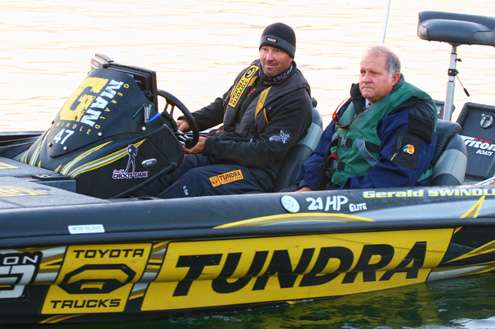
JASPER, Ala. — Lewis Smith Lake’s bass profile is typical of many man-made impoundments in the middle South.
Spotted bass thrive in the lower portion of many lakes from northern Alabama to North Carolina. Clear, deep water and immense schools of shad support prolific populations of spotted bass. They all but relegate the ranks of the largemouth to the headwaters. The clear water turns dingy. The depth rises closer to the surface. And the laydowns and structure largemouth prefer is more available.
This dual personality of bass populations presents a conundrum for a tournament angler. Do you fish the numbers game for spotted bass? Make the long run for the quality largemouth bite? Or gamble on a mixed bag of both?
Those are questions facing a national field of anglers competing in the Bass Pro Shops Southern Open #3 on Smith Lake.
Gerald Swindle’s tactical approach is simple when deciding between largemouth and spotted bass. Choose one and don’t look back. The restraints of time pose too great a risk for sustaining a tournament winning game plan.
“You spread yourself too thin in a tournament like this if you try and spend 50 percent of your time on largemouth, then the rest of the day trying to catch spots,” he said. “When you go back and forth, you burn time and confuse yourself.”
The Bassmaster Elite Series pro rarely sees Smith Lake even though it’s a half-hour drive from his home. Swindle spends most of his time on the Tournament Trail chasing largemouth. That’s why he’ll target them in this tournament.
“I might spend all day on a largemouth pattern, but my odds of catching one or more quality fish are better,” he said in comparing the spotted bass option. “I know some guys might be down lake culling a limit before I get mine. But chances are those fish are just inside the legal size limit for the tournament. They’ll all weigh the same.”
That’s due in part to the prolific nature of the spotted bass. They grow quickly and rarely reach trophy size like the largemouth. Most spotted bass average 2 pounds when fully mature. In some states, like South Carolina, the spotted bass is considered an “invasive” species.
Swindle never falls to the temptation of scrambling to catch a mixed bag. It’s a common pattern on lakes with spotted bass and largemouth. The strategy many will follow is to fill a quick limit of spotted bass and then head upriver for a kicker largemouth that anchors the stringer.
“I fish backwards from what a lot of guys do when given the two choices,” he explained. “I’d rather go after the big bite first thing in the morning; get a good quality fish or more in the livewell.”
He also recognizes the riverine setting fishes smaller than the lake. Crowded conditions call for savvy tactics.
“I don’t beat the bank. I avoid the obvious shoreline cover like laydowns,” he said. “I’ll fish deeper water and look for submerged cover that I think nobody has targeted.”
Swindle sums it all up in his classic, whimsical style.
“My granddaddy used to always say that if you try and do two things at the same time, you’ll only do one of them well.”

